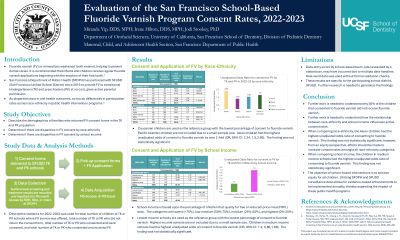Preventive
202 - Evaluation of San Francisco School-Based Fluoride Varnish Program Consent Rates


Miranda Yip, DDS (she/her/hers)
Resident
University of California - San Francisco-3yr
University of California San Francisco
San Francisco, California, United States
Jean Star, DDS, MPH
Assistant Professor
University of California, San Francisco
University of California San Francisco
San Francisco, California, United States- TL
Thuan Q. Le, DDS, PhD
Interim Program Director
University of California, San Francisco
San Francisco, California, United States
Presenting Author(s)
Research Mentor(s)
Program Director(s)
Since 2016, the San Francisco Department of Public Health has partnered with the San Francisco Unified School District to offer fluoride varnish (FV) to transitional kindergarteners (TK) and preschoolers (PK) at no cost. However, this is contingent on active parental consent. Given disparities in oral health outcomes, this study examines the demographics of families who consented to FV, focusing on differences by race-ethnicity and school income.
This study used descriptive statistics to analyze data from the 2022-2023 academic year, evaluating the number of children at TK or PK schools who were offered FV, consented, and received treatment. The analysis revealed disparities in FV consent and application rates by race-ethnicity and school income. Among children who consented to FV, Asian children by race-ethnicity had the highest consent rates (86%) with an unadjusted odds ratio (OR) of 2.34 (95% CI: 1.5, 3.66). Medium income school children had the highest consent rates (83%) with an OR of 1.2 (95% CI: 0.86, 1.68). While disparities were noted across different race-ethnicity and school income groups, these trends were not statistically significant.
These initial findings reveal a varied return of consent forms across race-ethnicity and school income groups, suggesting an underlying disparity in engagement with school-based oral health programs. These trends suggest parental engagement as a potential barrier to participation. Understanding the influence of race-ethnicity and socioeconomic status on FV consent rates is crucial. Overall, this research underscores the importance of enhancing public health interventions to address barriers and improve equity in oral health preventive care.
Identify Supporting Agency and Grant Number:

.jpg)